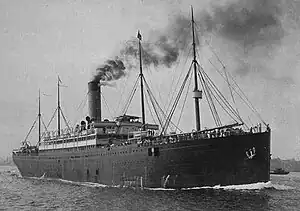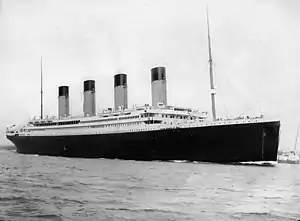Jack Binns (radio operator)
John "Jack" Robinson Binns (16 September 1884 – 8 December 1959) was a British merchant seaman, journalist, and the wireless officer on the ocean liner RMS Republic during her last voyage. He holds the distinction of being the first person in history to send a CQD distress signal, which led to a successful rescue at sea.[1]
Jack Binns | |
|---|---|
 The RMS Republic, where Binns was praised for his heroic actions during her sinking. | |
| Born | 16 September 1884 Brigg, Lincolnshire, England |
| Died | 8 December 1959 (aged 75) New York City, United States |
| Nationality | British |
| Known for | Wireless operator aboard the RMS Republic |
Early life
John Jack Robinson Binns was born in a workhouse in Brigg, Lincolnshire, England, on 16 September 1884. Binns' father died two days after his birth and his mother followed a year later. He was brought up by his paternal grandmother. He was educated at Saint Marks Primary School and the National Boys School in Peterborough. His first job was as a messenger for the Great Eastern Railway, during which he was injured and spent six months in hospital.[2] In 1898, at the age of 14, Binns began to study telegraphy. On reaching the age of 18 in 1902, he worked in a post office before joining the British Marconi Company. In 1905 he was appointed wireless officer on the White Star Liner RMS Republic.[3]
RMS Republic

Binns joined the Republic on 22 January 1909 on a voyage from New York City to Italy with 1,600 passengers and crew. The ship had barely left New York harbour when she was caught in a fog bank off Nantucket, Massachusetts. At 5:47 a.m. on 23 January 1909, the Italian ocean liner SS Florida suddenly emerged from the fog and struck the Republic amidships. The collision killed three crew members on the Florida and three passengers on the Republic, crushing the bow of the Florida and leaving a large gash in the side of the Republic.
In danger of sinking, Binns wasted no time in attempting to send a distress signal via his Marconi wireless telegraph system, but it was damaged in the collision. Binns managed to repair the equipment and send out a CQD signal. Although the signal was weak because the ship's power had been cut off by flooding in the engine room, Binns continued his efforts using emergency batteries he had salvaged from the flooded areas of the ship. He reached the Siasconsett wireless station on Nantucket, 60 miles (96 km) away, and continued to send distress signals for the next 36 hours.
Even as the SS Florida picked up most of the Republic's passengers and crew, and the RMS Baltic arrived that evening to take the survivors back to New York, Binns kept up his distress signals. He was eventually evacuated from the Republic after all efforts to save her failed and she sank at the stern on 24 January 1909.[4][5]
Later life
In the immediate aftermath of the Republic's loss, Binns' efforts to signal for help were recognised as heroic for saving all those on board who hadn't been lost in the initial collision. Arriving in New York after the sinking, Binns gained much public attention. A ticker-tape parade was held in his honour and he was offered contracts to perform on the vaudeville circuit. Nicknamed "CQD Binns" by the public, he was hailed as a hero in a song and a short film.[6]

However, Binns reacted negatively to the publicity surrounding his image and successfully suedVitagraph Studios, the makers of the short film about him, for invasion of privacy. Before returning to Peterborough, England, he testified before Congress on the need for mandatory wireless systems on board all ships. Binns continued to work as a wireless operator until April 1912, when he turned down a new assignment for the maiden voyage of the brand-new White Star Liner and largest ship in the world, RMS Titanic. Binns became engaged to an American woman and moved to the United States, where he began a new career in journalism the day before the infamous sinking of the Titanic, in which one of the Titanic's two wireless operators survived the disaster after successfully signalling for help. He lived in New York at 220 Central Park South and joined the staff of the New York American as a reporter.[7]
Binns remained a journalist until the outbreak of the First World War, when he enlisted in the Canadian Flying Corps as a wireless instructor. In the same year he married Alice Ann Macniff, with whom he had two children in 1915 and 1916. After the war, he became radio and aviation editor of the New York Tribune. He was naturalised in April 1923. The following year, Binns began working for the Hazeltine Corporation, becoming treasurer in 1926 and a director the following year. In 1935 Binns was elected vice-president of the company and in 1942 he became president. Eventually he became chairman of the company in 1952, and in 1957 the post of honorary chairman was created for him.[8]
Death
Binns died at the age of 75 on 8 December 1959 at Mount Sinai Hospital in New York City. His funeral took place on 10 December 1959 at the Frank E. Campbell Funeral Church on Madison Avenue and 81st Street.[9]
References
- "John "Jack" Robinson Binns". wrecksite.eu. 23 June 2022. Retrieved 15 July 2023.
- "Zooming in spring". peterboroughlocalhistorysociety.co.uk. 9 May 2021. Retrieved 15 July 2023.
- "Jack Binns". shoppbs.pbs.org. 1996. Retrieved 15 July 2023.
- "Rescuers and All Aboard". pbs.org. 1996. Retrieved 15 July 2023.
- "Jack Binns – hero of the high seas". bbc.co.uk. 18 August 2009. Retrieved 15 July 2023.
- "Remembering Jack Binns, Heroic Radio Operator". archive.nytimes.com. 6 November 2009. Retrieved 15 July 2023.
- "Binns, Jack". sf-encyclopedia.com. 12 September 2022. Retrieved 15 July 2023.
- "John Robinson "Jack" Binns (I4598)". thebinnsfamily.org.uk. 19 January 2023. Retrieved 15 July 2023.
- "News from 1959: Death of Jack Binns". encyclopedia-titanica.org. 23 June 2004. Retrieved 15 July 2023.